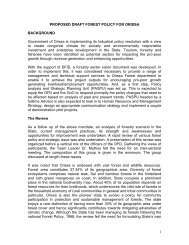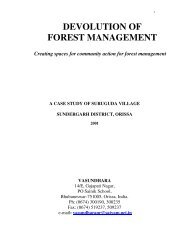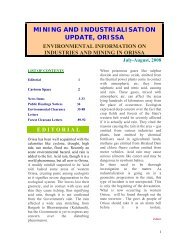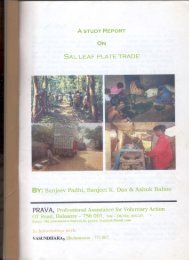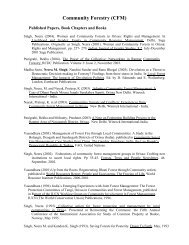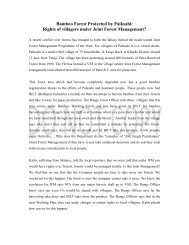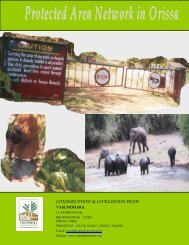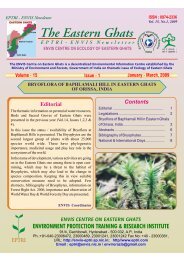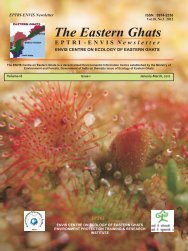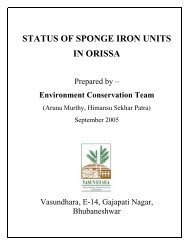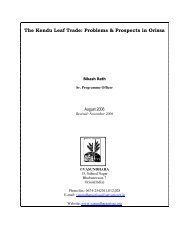Bamboo in Orissa: Trade and Livelihood Perspective - Vasundhara
Bamboo in Orissa: Trade and Livelihood Perspective - Vasundhara
Bamboo in Orissa: Trade and Livelihood Perspective - Vasundhara
You also want an ePaper? Increase the reach of your titles
YUMPU automatically turns print PDFs into web optimized ePapers that Google loves.
All rights reserved by VASUNDHARA(www.vasundharaorissa.org). For any clarification, contact author at sunlit1968@yahoo.co.<strong>in</strong><br />
Gender- <strong>and</strong> caste-based biases:<br />
There are several artisan villages/hamlets(like the harijan sahi of Gania near Dasapalla)<br />
where women have absolutely no role <strong>in</strong> bamboo-ware production whereas <strong>in</strong> some other<br />
villages(like Sahada near Kujang) their role <strong>and</strong> expertise <strong>in</strong> this profession is equally<br />
important. On the other h<strong>and</strong>, <strong>in</strong> Saharpada, mak<strong>in</strong>g bamboo brooms is essentially a<br />
women's job while mak<strong>in</strong>g mati-jhudi is a men's job. In Sariapada(Dhenkanal district),<br />
both men <strong>and</strong> women work on bamboo products; but br<strong>in</strong>g<strong>in</strong>g bamboo from forests is<br />
considered as a men's job while sell<strong>in</strong>g the products is a women's job(Source: Sachitra<br />
Vijaya).<br />
On enquiry it was found that the factor, which controlled the role of women <strong>in</strong> bamboo<br />
work, is not related to any socio-religious taboo. Rather, the extent to which muscle power<br />
is required <strong>in</strong> the work seems to be the most important reason beh<strong>in</strong>d. For <strong>in</strong>stance, <strong>in</strong><br />
w<strong>in</strong>now mak<strong>in</strong>g, the weav<strong>in</strong>g part is done by women; but the thick(about 1") halfrectangular<br />
'arm'(baha) which is used to impart strength <strong>and</strong> support to the whole structure,<br />
is tied by the males s<strong>in</strong>ce this requires more muscle power than concentration <strong>and</strong> care.<br />
Usually weav<strong>in</strong>g of coarse class requires maximum muscle power as the strips are thicker<br />
<strong>and</strong> often heavier. Hence, women are not supposed to work <strong>in</strong> this case. On the other h<strong>and</strong>,<br />
they are comfortable with the other two classes.<br />
However, <strong>in</strong> some artisan villages like Kundhei (Puri district) women express confidence<br />
that they could do all the jobs that is supposed to be done by men only. For some women<br />
like widows this is a compulsion when there are no able male members <strong>in</strong> the family to<br />
assist.<br />
Interest<strong>in</strong>gly enough, artisan villages/hamlets do not usually work on all the three classes.<br />
If a village works on the coarse type of weav<strong>in</strong>g, then the other two types are usually found<br />
absent there. Similarly, those resort<strong>in</strong>g to the 'medium' <strong>and</strong>/or 'f<strong>in</strong>e' type of weav<strong>in</strong>g avoid<br />
the coarse one. It is for this reason that most of the artisan villages are either absolutely free<br />
from any <strong>in</strong>volvement of the women <strong>in</strong> this work, or are full of women workers.<br />
Usually most of the bamboo-artisan communities belong to the schedule caste (viz., pana<br />
or buna-pana, hadi, dama, k<strong>and</strong>ra, etc.). In Khunta(Mayurbhanj) they are represented by<br />
the mahali people <strong>and</strong> <strong>in</strong> Ganjam district, by the mediris. Often the type of weav<strong>in</strong>g differs<br />
accord<strong>in</strong>g to the caste. For <strong>in</strong>stance, the production of kula <strong>and</strong> baunshia is usually found<br />
to be conf<strong>in</strong>ed to the dama <strong>and</strong> hadi communities (caste) whereas that of doli, taati <strong>and</strong><br />
rodara is conf<strong>in</strong>ed to buna-pana (literally mean<strong>in</strong>g, the weaver pana which dist<strong>in</strong>guishes<br />
the group among the pana caste depend<strong>in</strong>g on bamboo-weav<strong>in</strong>g) community. Items<br />
produced by all or most of the communities are rare <strong>and</strong> g<strong>and</strong>ua is an example of that.<br />
65



